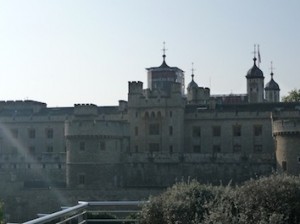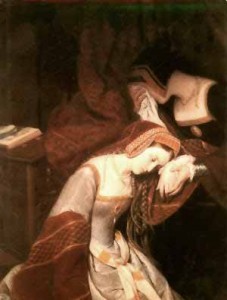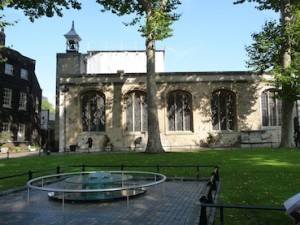When searching for a place to visit that has a strong connection to Anne Boleyn one cannot forget the Tower of London. Situated in central London, on the north bank of the River Thames, it has looked over the city of London for over 900 years and has served as a royal palace and fortress, prison and place of execution, an arsenal, and royal mint, a royal menagerie and jewel house. And it is here that Anne Boleyn stayed on the eve of her coronation in 1533- at the peak of her career. It is also where she enjoyed a number of coronation celebrations and feasts with her husband, Henry VIII, prior to her coronation. Contrary to popular belief, virtually nothing remains of the Royal Palace and Queen’s apartments where Anne Boleyn spent these memorable days.
In complete contrast to the days prior to her coronation, the Tower is also the setting for Anne’s incarceration and execution. In a terrible twist of fate, Anne Boleyn spent her final days and darkest hours in the same apartments that had played host to lavish celebrations and revelry only three short years before.
In Victorian times, it was claimed that Anne was lodged in the current day ‘Queen’s apartments’ but we now know that this is incorrect as the present day buildings were built a number of years after Anne’s execution. This information was circulated to meet a strong public demand to see and know the physical space where Anne Boleyn spent her last hours.
The Tower of London is also home to Tower Green. Here, a monument marks the site of the scaffold where seven famous prisoners were privately executed. On the 19th May 1536, Anne was the first woman to suffer death by beheading for treason. She was followed by four other women: Margaret Pole the Countess of Salisbury (1541), Catherine Howard (1542), Jane- Viscountess Rochford (1542) and Lady Jane Grey (1554).
The poem written on the monument reads:
Gentle visitor pause awhile, where you stand death cut away the light of many days. Here jewelled names were broken from the vivid thread of life, may they rest in peace while we walk the generations around their strife and courage under these restless skies.
The Tower of London’s Chapel Royal of St Peter ad Vincula is the final resting place for Queen Anne Boleyn. The chapel was rebuilt in its present form in 1519-1520 in the early years of the reign of Henry VIII and is also the burial place for some other very famous Tower prisoners including: Catherine Howard, Jane Grey, Sir Thomas More and Bishop John Fisher.
After Anne’s execution, her ladies-in-waiting covered Anne’s head in a white cloth and wrapped her body in a sheet. They then carried Anne into the chapel, unclothed her and lay her corpse in an elm chest. She was then buried in an unmarked grave, close to her brother George Boleyn, in the chancel of the chapel.
For all loyal Anne Boleyn ‘subjects’, the tower is a must-see destination. It is a chance to get as close as possible to the physical remains of this remarkable and courageous woman and pay homage to her life. It is also an opportunity to explore a space that would have once held such triumphant memories for Anne.
For opening times and other visitor information visit the Tower of London Website.
Sources:
Thurley, Simon; Edward Impey and Peter Hammond. The Tower of London – Official Guidebook, 1996.
Ives, E. The Life and Death of Anne Boleyn, 2004.



















Brilliant summary of the Tower Of London, it really is a muse see for all history fans!
Wow, so much more info that I expected. I never knew so much on Anne Boleyn!
You should watch the Tudors on Netflix if you haven’t already, just note that King Henry VIII was a lot bigger than the actor who played him.
But still, it’s really good
Concerning the monument on Tower Green, I believe Alison Weir wrote that the actual site of the scaffold was in front of the Jewel House and not the present marked location. (apologies to Alison if this is wrong). Could you elaborate on this?
What a fascinating article on the Tower of London! The historical details and vivid descriptions really bring the past to life. It’s a must-visit for anyone interested in British history.